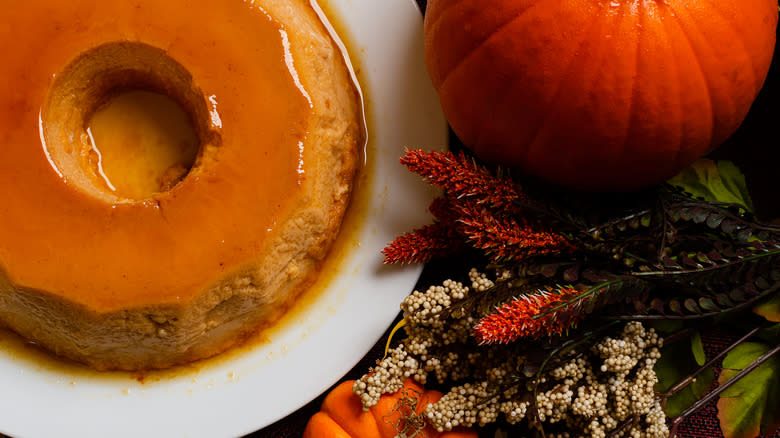Flan Vs. Panna Cotta: What's The Difference?

Sometimes life's greatest pleasures can come from the smallest things. Any dessert connoisseur will tell you that those things are often delicious sweet treats that can be made in just a few simple steps. This is where flan and panna cotta come into the picture. On top of being so easy to make, these mini desserts also taste incredible. They're sweet and comforting with a velvety smoothness, stealing your heart one decadent bite at a time. Perhaps that's one of the main reasons why they're occasionally confused with one another, or even mistaken as the same variety. When placed side-by-side, however, you'll have no problem differentiating these two dishes.
Although slightly similar in their jello-like appearances, flan and panna cotta actually have very distinguishable flavors and textures. They also come in very different colors and depending on the specific cuisine, different toppings. These characteristics stem from a fundamental difference in ingredients, cooking methods, and of course, origins. Taking a deeper dive into these aspects, there'll be no doubt that they truly are two distinguished desserts.
Read more: 30 Types Of Cake, Explained
What Is Flan?

Flan is an egg custard that originated in ancient Rome, was later refined by the Spaniards, and then quickly integrated into Latin America's culinary heritage. It's primarily made with eggs, milk, sugar, and vanilla. Across different cuisines, there may be tweaks and changes in this ingredient list. For example, in Puerto Rico, flan de queso uses cream cheese for an extra rich taste and texture. Then there's also flan de coco that uses coconut milk for a tropical twist. In Mexico, you'll find flan de calabaza — a pumpkin-infused creation that's often enjoyed during the fall.
No matter the variations, flans are generally made in a similar way. The ingredients are mixed together and poured over a pan with caramel sauce spread at the bottom and then baked, often in a water bath to ensure even heat distribution and prevent curdling. Once out of the oven and inverted, this golden dessert is coated in a glossy amber-colored sheen of caramel sauce. With eggs as the main ingredient, it has a rich, buttery taste enhanced by the caramel sauce's deep sweetness. Texture-wise, it's creamy and smooth with a crème br?lée-like softness. As for presentation, both small and large molds are used, so you may find them in various sizes, ranging from palm-sized to Bundt cake-shaped ones. Although the caramel sauce is most commonly used, you can garnish it with dried fruits, chocolate sauce, coffee, whipped cream, and more.
What Is Panna Cotta?

Panna cotta is commonly known as an Italian delicacy that over time, has become well-loved worldwide. The name "panna cotta" translates to "cooked cream" in Italian, which perfectly describes its preparation method. A mixture of cream, milk, vanilla extract, sugar, and gelatin is simmered on the stovetop, poured into small containers, and then left to chill for a few hours. It can be also flavored with fruit syrup, citrus zest, or other ingredients for a more diverse flavor profile.
Panna cotta leans toward the milder side, with a milky vanilla taste taking center stage and soft, floral notes peeking through in the back. Depending on the accompanying topping, it may also carry fruity, nutty, and various other flavor notes. This Italian dessert showcases a delicately luscious texture that feels almost like silk wrapping around your taste buds - a perfect complement to its gentle sweet notes.
Panna cotta comes almost exclusively in small servings. It can be garnished with fruit compotes, nuts, frozen fruits, a sprig of fresh herbs, or anything you feel like getting creative with. In Middle Eastern cuisine, it's often served with rosewater, pistachios, or pomegranate seeds. For Asian countries, specialty ingredients like pandan syrup or saffron are also utilized to create a unique flavor twist. This dessert is the perfect blank canvas for experimentation, with a versatility that keeps it endlessly interesting and non-repetitive.
Read the original article on Tasting Table.
